Japanese Mystery Cats- Revisiting the Yamapikarya
Posted by: mystery_man on February 24th, 2012
“The Yamapikarya – Japan’s Mystery Cat”
By Brent Swancer
Recently while researching wildlife on some of Japan’s more remote islands, and I couldn’t help but think of this article I wrote here awhile back on Cryptomundo concerning a mystery cat said to lurk on one of Japan’s most remote islands. I have decided to revisit this enigmatic creature here.
Is there a large mystery cat roaming the jungles of Japan’s remote Iriomote Island?
Iriomote island lies about 200 kilometers east of Taiwan, 1,240 miles Southwest of Tokyo, and is part of Japan’s Okinawa archipelago of islands.
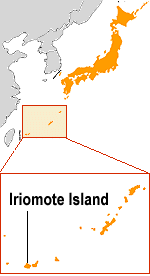
At approximately 289 square kilometers (113 square miles) in area, Iriomote is the largest island in the Yeayama Shoto island chain, and is the second largest island in all of Okinawa. Iriomote is considered to be one of the great wild areas left in Japan, with 90% of its mountainous land made up of lush, pristine subtropical jungle and mangrove swamps.
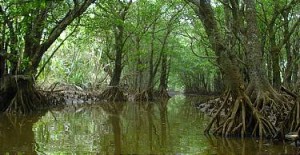
Much of this land falls within the Iriomote National Park or is protected state land, with its plants and animals protected by a district forestry service.
This beautiful, untouched wilderness is home to many rare and unique animals and plants, some found nowhere else on Earth, and due to this biological diversity, Iriomote island has sometimes been called “The Galapagos of East Asia.”
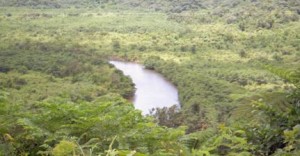
Iriomote is already home to one known species of wildcat, known as the Iriomote wildcat, or Iriomote cat (Prionailurus iriomotensis), commonly called the “Yamaneko,” or “mountain cat” in Japanese. The Iriomote wildcat is endemic to the island, meaning it is found only here and nowhere else in the world. This cat is so elusive that it was not formally discovered until 1967, and there are many people who have lived on the island their entire lives who have never seen one or are indeed even aware that it exists.
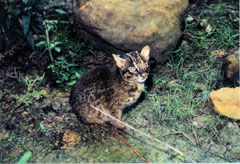
The Iriomote wildcat is approximately the size of a domestic housecat, around 50 cm long and weighing from 3 to 8 kg (6-18 lbs). It is dark or grayish brown in color, with lines on the neck that end at the shoulders and longitudinal rows of black spots that merge into lines on its flanks. The Iriomote cat is thought to be related to Asian leopard cats (Prionailurus bengalensis) native to Southeast Asia, although its exact taxonomy within this group is often disputed. It is one of the most “primitive” forms of extant cat in the world, and with only around 100 or fewer individuals remaining, it is also one of the rarest.
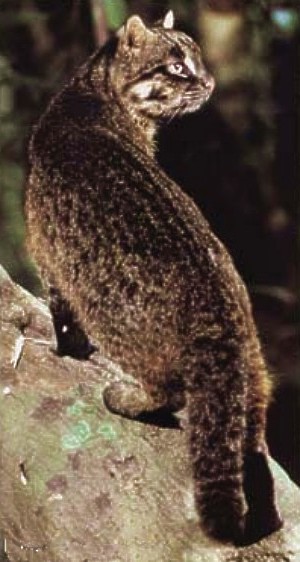
While the Iriomote wildcat is no longer a cryptid, there have long been stories and rumors of another type of larger cat living deep in the remote, mist shrouded jungles of the island.
Iriomote was originally not considered fit for human habitation due to the rampant malaria once found there. The island had primarily an agricultural role, being used for rice farming due to its abundant water, and human settlement on Iriomote island didn’t begin in earnest until after World War II, with the eradication of malaria.
At the time of this population growth, sightings began to surface of large mystery cats in the wilderness. This mystery cat, now known as the “Yamapikarya,” was first known through reports by wild boar hunters, who are known to venture far off the beaten trails into the remote jungles. These hunters told of a large cat in the mountains and swamps of the island’s interior, often described as being similar to a leopard or jaguar.
The Yamapikariya is described as being between 1 and 1.3 meters in length, much larger than the Iriomote wildcat, and stoutly built. Its coat is said to be yellow, dark yellow, or orangish in color, with large, black spots. The tail of the cat is remarkably long, an interesting detail that is often mentioned in reports of the animal.
Another detail that remains consistent in reports is the remarkably arboreal nature of the mystery cat. The Yamapikarya is often reported in trees. They are considered to be excellent climbers and have even been seen to seemingly swing from tree to tree in a manner similar to some kind of primate.
Since the first reports by these hunters, there have been at least 47 eyewitness reports on record, possibly even more. Sightings of the cats reached their pinnacle in the 50s and 60s, after which reported encounters with the cats diminished considerably, which has been speculated to be most probably due to the cats moving deeper into the uninhabited areas of the island to avoid humans and increasing development in the coastal areas. In recent years, sightings have dropped off almost completely, yet some intriguing and often fairly credible recent sightings still pop up from time to time.
One such sighting occurred in the summer of 1978, when a hunter reported seeing a large cat lounging up in a tree. The eyewitness described the cat as having spots that were “oddly shaped,” although exactly how they were odd is not mentioned, and a long tail that hung down “like a vine.” After observing the cat for several minutes, the hunter reports that the cat seemed to suddenly realize it was not alone, after which it bounded down the tree and into the forest with what he says was extraordinary speed and agility. The cat did not make any sounds.
In 2003, a Mr. Shimabukuro, who runs a fishing boat on the island, spotted a Yamapikariya while he was in the mountains setting wild boar traps. According to his report, he was setting the traps and found himself walking along a gravelly open clearing. After walking along this clearing for around 100 meters, he was surprised when a large, spotted cat, estimated at slightly over a meter long, suddenly leapt down from the top of a large boulder, landing right in front of him before disappearing into the underbrush. As the cat retreated, the man noticed that it was spotted, and had a remarkably long tail. He recalled being startled, and claims to have never seen anything like it on the island.
In September of 2007, the cat was seen by a Mr. Aiyoshi, who is a professor at Shimane University in Japan. According to his report, the professor was sitting on a beach fishing for a research project when a dark shape appeared from the thick forest just 2.5 meters from where he sat. His first bewildered reaction upon realizing an animal was there was that a wild boar had crept out of the trees, but it became quickly apparent this was a large cat which he describes as being a meter in length, with a very long tail and black spots, and looking similar to a leopard. The professor reported how the cat stared right at him before calmly slinking into the shadowy forest once more.
What do reports like this mean? The only two types of cat known to exist on the island are the endemic Iriomote wildcat, and introduced house cats, yet it seems fairly obvious from physical descriptions of the mystery animal that what is being seen is neither of these.
The Yamapikariya is described as being much larger than either of these cats, and the animal’s coloring does not match up either. The Iriomote wildcat also does not have a particularly long tail, which may seem like a minor point, but is a feature that is often mentioned in Yamapikarya reports. The long tail is therefore apparently a striking enough attribute of the animal to catch people’s attention and make it noteworthy. There are dogs on the island, but again the reports do not seem to be describing a typical domestic dog either. It also seems that there were likely few, if any, domestic cats or dogs on the island during the time when the first sightings of the Yamapikarya were being reported. In addition, many eyewitnesses of the mystery cat have been hunters, who would probably be quite familiar with the animals of the area.
Whatever is being seen, it seems questionable that the reports can be attributed to misidentifications of dogs or known cats on the island. It seems apparent that the mystery cat is likely something else. But what?
Some have proposed that the Yamapikariya is merely misidentified wild boars that have been seen. This explanation does not seem to be a realistic suggestion in light of what has been seen. Not only do wild boars look nothing like a large cat, but the coloring is also way off, and they don’t climb trees.
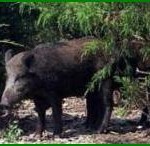
It must also be remembered that many of the sightings of the Yamapikariya have been made by hunters, indeed wild boar hunters no less, who got a good look at the animal in question. It seems fairly unlikely that a wild boar hunter would mistake a wild boar for a large spotted cat, so what else could the Yamapikarya be?
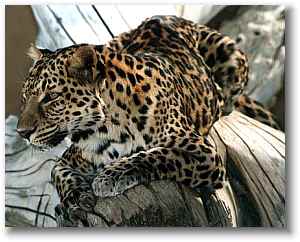
One possibility is that what is being seen is a leopard (Panthera pardus), above. While many people may think of Africa when they think of leopards, these cats actually have the widest distribution of any wild cat, and are found in eastern and southeastern Asia as well. Leopards are also very robust and adaptable, inhabiting a wide range of habitats from grassland to jungle, and could likely do quite well on Iriomote. Their black rosette marked coat and fairly stocky build are a good match for the descriptions of the Yamapikariya.
As I have mentioned, many sightings of the Yamapikariya have also been made in trees, including sightings by people who mention being astonished by the speed and agility with which the cat can climb. This would fit well with leopards as they are known for their climbing prowess and for resting or feeding in trees. At typical sizes of 1.3 to 1.9 meters (around 4 to 6 feet) long with a tail 3 to 4 feet long, the leopard tends to be a bit on the large side for what is reported for the Yamapikariya, but it is still worth considering.
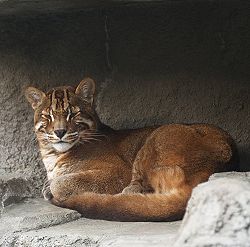
It also seems vaguely possible that we could be dealing with another cat native to Asia, the Asian golden cat (Padofelis temminickii). At a tad less than a meter long, the size is somewhat comparable to the Yamapikarya, and although the golden cat typically has a mostly plain golden coat with limited or faded spots, there is a recessive color variant in China that exhibits very leopard -like markings similar to a leopard cat.
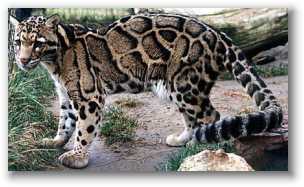
One animal that is perhaps the best candidate for the Yamapikariya is the clouded leopard (Neofelis nebulosa) – directly above and below – of Asia. These cats are not really a type of leopard, but rather are named for their coloration, which is a grayish, yellow, or yellowish grey, with cloud shaped black spots covering the body.
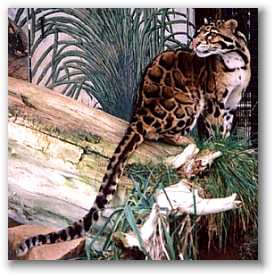
This seems very similar to the coloration that has been reported by eyewitnesses of Iriomote’s Yamapikarya, and the cloud shaped spots could produce the report that described the spots as “oddly shaped.” The Clouded leopard ranges in size from about 2 to 3 feet long, not including the additional length of the tail, which at 2 or 3 feet long is the same length as the body. This size range and the long tail coincides well with what has been described in Yamapikarya sightings. Since the clouded leopard is a highly arboreal animal and considered one of the best climbers in the cat family, it also fits in well with the reports of the Yamapikarya in trees and its reportedly excellent climbing ability.
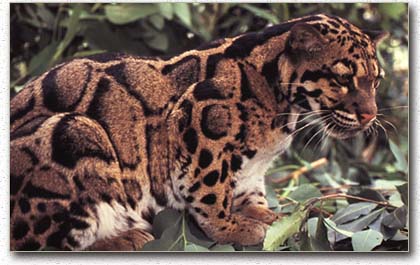
In addition to these physical traits, the range of the clouded leopard covers Eastern and Southeast Asia, including a subspecies in nearby Taiwan (Neofelis nebulosa prachyurus), which is now extinct in the wild. In fact, much of the range of the clouded leopard overlaps that of the smaller leopard cats, which are related to the known Iriomote wildcat.
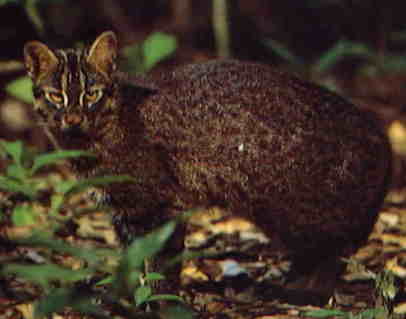
Since the Iriomote wildcat (above) evolved from leopard cats that became isolated on the the island long ago, it seems not too far a jump to suggest that perhaps clouded leopards in the same range could have inhabited the island as well. The subtropical habitat on Iriomote would be also be very comfortable indeed for these cats, since prey species are abundant and clouded leopards tend to prefer tropical and subtropical forests, as well as mangrove swamps.
The clouded leopard is also an extremely elusive and secretive animal, that is rarely seen even in its known habitat. These cats are so reclusive that they are still little understood, and much of what is known about them has been gleaned from observing captive specimens. They are a good candidate if you are looking for a cat that could remain undiscovered on Iriomote.

This brings us to the question of whether a population of any of these cats could really remain hidden on this island.
Although Iriomote Island sounds small at only 113 square miles in area, much of it is completely uninhabited. There are only around 2,000 permanent residents on the island, who are settled in the coastal areas. Infrastructure is poor, with no airstrip (the island is only accessible by boat), and only one main road, which wraps around the coast to connect the various villages. The interior of the island is thick with primeval subtropical jungle and mangrove swamps so dense as to be practically impenetrable and inaccessible by humans, with no roads and few trails.
It is important to consider that the known wildcat is almost never seen even by long term residents, if at all, even though the cats tend to favor low lying coastal areas where the bulk of the island’s human population live. The Yamapikarya could very possibly be lurking more in the mountainous inland regions well away from humans. Also like the known Iriomote wildcat, the clouded leopard and leopard are predominantly nocturnal and well camouflaged, which when taken together with the remote, impassable jungle habitat, makes it seem at least plausible that a small population could remain concealed on the island.
If the Yamapikarya is indeed one of these cats, it seems likely that in their long isolation the cats have evolved uniquely on the island much as the Iriomote wildcat did, making it very possible that it could be an entire new species within its genus, or at the very least a new subspecies. It could very well be that whatever type of cat it is, it could be another animal found only on Iriomote and nowhere else in the world.
Unfortunately at this point, no physical evidence of the Yamapikarya has ever been found, but the mystery remains. Something has been seen on the island that does not match with other animals known to be there. Is it a new type of clouded leopard, leopard, or golden cat? Could it even be a new genus of cat? Is it some other type of large cat, an exotic, even perhaps some type of presumably extinct prehistoric cat? Is it a wild boar, a feral cat, or a dog? Or is it perhaps just a figment of people’s imaginations?
The answer to these questions could be out there right now, prowling the jungles of Iriomote Island.
About mystery_man









As a big fan of all cats, what I came away with from this article was a real concern for the continuation of the Iriomote Wildcat. My concern rests with the introduction of domestic cats on the island.
Cats being cats, if they are close enough in size, they will mix with each other. In this country, I have seen personally the results of domestic cats breeding with bobcats.
The danger to the Wildcats is that they will interbreed with domestic cats to the point that the Wildcat gene pool is disrupted. The result would be the diminishion of the true breed, replaced by hybrids that are neither wild nor feral.
As to the big mystery cats, we will need to see some photos to determine just what they are. Some type of leopard, in my opinion.
Desertdweller- Yes, introduced feral cats are a definite threat to the Iriomote cats, although to what extent has not yet been firmly established.
Interbreeding has not been determined to have become a real problem for the cats on Iriomote at this time, although the threat certainly is there. Feral introduced house cats cause a list of problems other than inbreeding, though. For instance, a big concern is that feral house cats harbor feline diseases that they then transfer to the wildcat population. This is an even more immediate and potentially disastrous implication than interbreeding for the endemic wildcats.
Feral house cats can also compete directly for prey. Cats are territorial and house cats are bolder than the native cats, giving them the potential to chase the shyer native wildcats away from their habitats and hunting grounds.
At any rate, the main threat for the endemic Iriomote wildcats at the current time is cars. Development in the cats’ favored coastal hunting areas has led to more roads, and cars are killing them off at an alarming rate. Efforts to stall this trend have met with little success.
Although there is a rather large protected reserve set aside for Iriomote wildcats, it happens to be situated in the uninhabited interior of the island, whereas the wildcats prefer the coastal areas that of course have more development. Since the native wildcats aren’t really hanging out in the wildlife reserve, it is proving to be of little help in protecting these cats.
I wonder if the wildlife reserve, while not doing much for the known native species, might just be harboring something bigger and more mysterious that does favor this more remote domain away from human eyes.
I do not know which possibility of mystery cat we have there, but all of the possibilities are beautiful specimens. Just look at that photos! Beauty such as this needs to be protected and saved.
Awesome article with fantastic photographs!
Thanks mystery_man, That was an awesome delicious little cryptosnack! I vote for clouded leopard myself, so I google earthed around the place, but didn’t see any. It sure is beautiful though and it’s inspiring to see places like that, so isolated and relatively unspoiled, amidst so many people. To have both the extremely rare neo-recognee and a big prize cryptid there, makes the place very intriguing. I love it! Thanks.
Intriguing and well written- thanks! Beyond the identity of the cat, I would be interested in the ecology that allows a viable population of such a large predator to exist in such a small area. I think I’ll crunch the numbers a little and see what comes up, it might give a little insight into the mystery cat’s identity.
Nice article mystery_man, and interesting point Desertdweller about domestic cats breeding with bobcats. In PA it is not uncommon to see black cats prowling fields (exactly like those photos/videos on monsterquest/ youtube etc) ; most people are able to see the obvious to connection to domestic cats (they are often Garfield colored too). It is interesting to consider some of those ‘questionable’ videos as domestic cat/ larger bobcat hybrids…
Hey there, m_m! Long time no see!
Nice article! If yeti and sasquatch could be real I guess we have to go for this too as a possibiliity. It’s a small area for something like this to go unconfirmed. But as I frequently say: confirmed and frequently observed can be two different things. I would expect more road cross sightings.
As soon as I read: “…and have even been seen to seemingly swing from tree to tree in a manner similar to some kind of primate.”
I thought: clouded leopard, which can be very frisky in trees.
Thank you everyone for the positive feedback.
DWA- Hey there! I’ve just been very busy, but I’ve been lurking here. I plan to be popping up from time to time now though. I agree that clouded leopard is the best candidate, if indeed something is there at all. These cats are extremely good climbers and might appear to do something akin to the swinging from tree to tree described in the report. Unless it is a mystery primate? Oh, that would be a whole new article!;)
PoeticsOfBigfoot- Thank you. As far as the ecology of the island being able to sustain a population of predatory cats, that is of course a very valid point. I would keep in mind that this island is crawling with wild boar. Boars are all over the place here, and can actually be a nuisance to the people living there. This would be a viable large prey source. Also, leopards can and will survive off of pretty much anything they can get their claws on. Rodents, turtles, lizards, you name it they’ll eat it.
The large amount of small prey available, plus the abundance of wild boar, make it seem to me at least plausible that at least a small population of big cats could survive on the island. Large cats tend to require a large territory, but this seems something that isolated adaptation might have been able to overcome.
Whether the cats could survive here and remain hidden from humans is another story, but the island really has to be seen to be believed. I have been there personally and it really is mostly impenetrable jungle. It’s like the lost world over there and I wouldn’t be surprised if there are various undiscovered species there.
Anyway, thank you for your good input and it is good to see I have people thinking about this.
m_m: eye-opener about the island. I think you’ve discussed it here before but I don’t think you’d previously treated the big picture in such depth. Impressive. I’d agree that you’ve made a pretty good case to at least think about an unconfirmed big cat here, particularly since it seems to lack much reason to visit the places where the people concentrate (and the location of the roads might make my road-cross point less valid).
Were the boar introduced? I know that in the places in the US where they’ve been brought in, “nuisance” would adequately describe the issue.
Aaaahh! Reading one of Mystery_man’s posts is like enjoying a bowl of fine sake.
Kampai!! 🙂
Sounds like a clouded leopard. Or a close relative. Would love to visit the Island some day. Sounds awesome